Welcome to the Nanopore Community
Order MinION devices and consumables
Visit vwr.comLigation sequencing gDNA V14 - Adeno-associated virus sequencing (SQK-NBD114.24)
Version for device: MinION
Introduction to the protocol
Overview of the protocol
Overview of the protocol
-
Introduction to the adeno-associated virus sequencing protocol
This end-to-end protocol describes how to extract recombinant adeno-associated virus (rAAV) vectors using the PureLink™ Viral RNA/DNA Mini extraction kit before sequencing using the Native Barcoding Sequencing Kit 24 V14 (SQK-NBD114.24). We have also included an optional annealing step post-extraction, however, we have found higher amounts of full-length inverted terminal repeat (ITR) sequences when the annealing step has been skipped before library preparation. Flushing steps have also been included as we recommend washing the flow cell to restore pores and to load a fresh library to continue sequencing.
The Know-How document is available for further details about the protocol optimisations and best practices.
Note: This protocol is currently validated to barcode up to six AAV samples for sequencing on a single flow cell.
Sequencing of the rAAV vectors enables the validation of vectors to ensure the transgene and promoter of interest are present, as well as identifying truncated rAAV genomes and any contamination. Validation is crucial in gene therapy to ensure the correct rAAV genomes are packaged into cells before therapeutic use.
Steps in the sequencing workflow:
Prepare for your experiment
You will need to:- Extract your DNA, and check its length, quantity and purity. The quality checks performed during the protocol are essential in ensuring experimental success.
- Ensure you have your sequencing kit, the correct equipment and third-party reagents.
- Download the software for acquiring and analysing your data.
- Check your flow cell to ensure it has enough pores for a good sequencing run.
Experiment workflow
Protocol step Process Time Stop option DNAseI treatment Perform DNAseI treatment of the rAAV lysates to remove any non-encapsidated DNA from the rAAV preparations 35 minutes - DNA extraction from rAAV Extract the rAAV vectors using the PureLink™ Viral RNA/DNA Mini Kit 45 minutes –80°C for long-term storage Annealing (Optional) Self-anneal any remaining (+) and (-) single strands of rAAV vector 80 minutes - End-prep Prepare the DNA ends for adapter attachment 20 minutes 4°C overnight Native barcode ligation Ligate the native barcodes to the DNA ends 60 minutes 4°C overnight Adapter ligation and clean-up Ligate sequencing adapters to the DNA ends 50 minutes 4°C for short-term storage or for repeated use, such as for reloading your flow cell
–80°C for long-term storagePriming and loading the flow cell Prime the flow cell, and load your DNA library into the flow cell 5 minutes Sequencing
You will need to:
- Start a sequencing run using the MinKNOW software which will collect raw data from the device and basecall reads in real-time. The reads will also be demultiplexed in MinKNOW.
- Start the EPI2ME software and use the wf-aav-qc workflow for analysis.
Equipment and consumables
- Materials
-
- 2.6 x10^10 GC of rAAV per sample
- Native Barcoding Kit 24 V14 (SQK-NBD114.24)
- Consumables
-
- MinION and GridION Flow Cell
- PureLink™ Viral RNA/DNA Mini Kit (Thermo Fisher, 12280050)
- Qubit™ ssDNA Assay Kit (ThermoFisher, Q10212)
- Qubit 1x dsDNA HS Assay Kit (ThermoFisher, Q33230)
- NEBNext Ultra II End repair/dA-tailing Module (NEB, E7546)
- NEBNext Quick Ligation Module (NEB, E6056)
- NEB Blunt/TA Ligase Master Mix (NEB, M0367)
- DNase I (NEB, M0303)
- Bovine Serum Albumin (BSA) (50 mg/ml) (e.g Invitrogen™ UltraPure™ BSA 50 mg/ml, AM2616)
- 50X annealing buffer (2.5 M NaCl, 500 mM Tris-HCl, pH 7.5)
- Ethanol, 100% (e.g. Fisher, 16606002)
- Freshly prepared 80% ethanol in nuclease-free water
- Nuclease-free water (e.g. ThermoFisher, AM9937)
- 0.2 ml thin-walled PCR tubes or 0.2 ml 96-well PCR plate
- 1.5 ml Eppendorf DNA LoBind tubes
- 2 ml Eppendorf DNA LoBind tubes
- Qubit™ Assay Tubes (Invitrogen, Q32856)
- Equipment
-
- MinION or GridION device
- MinION and GridION Flow Cell Light Shield
- Hula mixer (gentle rotator mixer)
- Microplate centrifuge, e.g. Fisherbrand™ Mini Plate Spinner Centrifuge (Fisher Scientific, 11766427)
- Microfuge
- Magnetic rack
- Vortex mixer
- Thermal cycler
- Multichannel pipette and tips
- Qubit fluorometer (or equivalent for QC check)
- Eppendorf 5424 centrifuge (or equivalent)
- Timer
- P1000 pipette and tips
- P200 pipette and tips
- P100 pipette and tips
- P20 pipette and tips
- P10 pipette and tips
- P2 pipette and tips
- Ice bucket with ice
- Optional Equipment
-
- Nanodrop spectrophotometer
-
This protocol requires 2.6 x10^10 GC of recombinant adeno-associate virus (rAAV) per sample.
A minimum of 2.6 x1010 GC of rAAV per sample has been trialled across six barcodes.
We recommend estimating genome copy number per ml (GC/ml) and to standardise rAAV inputs prior to DNAseI treatment. Droplet digital PCR (ddPCR) or qPCR are commonly used to quantify AAV vector genome numbers in titres.
-
Third-party reagents
We have validated and recommend the use of all the third-party reagents used in this protocol. Alternatives have not been tested by Oxford Nanopore Technologies.
For all third-party reagents, we recommend following the manufacturer's instructions to prepare the reagents for use.
-
Check your flow cell
We highly recommend that you check the number of pores in your flow cell prior to starting a sequencing experiment. This should be done within 12 weeks of purchasing for MinION/GridION/PromethION or within four weeks of purchasing Flongle Flow Cells. Oxford Nanopore Technologies will replace any flow cell with fewer than the number of pores in the table below, when the result is reported within two days of performing the flow cell check, and when the storage recommendations have been followed. To do the flow cell check, please follow the instructions in the Flow Cell Check document.
Flow cell Minimum number of active pores covered by warranty Flongle Flow Cell 50 MinION/GridION Flow Cell 800 PromethION Flow Cell 5000 -
Native Barcoding Kit 24 V14 (SQK-NBD114.24) contents
Note: We are in the process of reformatting the barcodes provided in this kit into a plate format. This will reduce plastic waste and will facilitate automated applications.
Plate format
Name Acronym Cap colour No. of vials Fill volume per vial (µl) DNA Control Sample DCS Yellow 2 35 Native Adapter NA Green 1 40 Sequencing Buffer SB Red 1 700 Library Beads LIB Pink 1 600 Library Solution LIS White cap, pink label 1 600 Elution Buffer EB Black 2 500 AMPure XP Beads AXP Clear cap, light teal label 1 6,000 Long Fragment Buffer LFB Orange 1 1,800 Short Fragment Buffer SFB Clear 1 1,800 EDTA EDTA Blue 1 700 Flow Cell Flush FCF Clear cap, light blue label 1 8,000 Flow Cell Tether FCT Purple 1 200 Native Barcode plate NB01-24 - 2 plates, 3 sets of barcodes per plate 5 µl per well Note: This Product Contains AMPure XP Reagent Manufactured by Beckman Coulter, Inc. and can be stored at -20°C with the kit without detriment to reagent stability.
Note: The DNA Control Sample (DCS) is a 3.6 kb standard amplicon mapping the 3' end of the Lambda genome.
Vial format
Name Acronym Cap colour No. of vials Fill volume per vial (µl) Native Barcodes NB01-24 Clear 24 (one per barcode) 20 DNA Control Sample DCS Yellow 2 35 Native Adapter NA Green 1 40 Sequencing Buffer SB Red 1 700 Library Beads LIB Pink 1 600 Library Solution LIS White cap, pink label 1 600 Elution Buffer EB Black 2 500 AMPure XP Beads AXP Clear cap, light teal label 1 6,000 Long Fragment Buffer LFB Orange 1 1,800 Short Fragment Buffer SFB Clear 1 1,800 EDTA EDTA Blue 1 700 Flow Cell Flush FCF Clear cap, light blue label 1 8,000 Flow Cell Tether FCT Purple 1 200 Note: This Product Contains AMPure XP Reagent Manufactured by Beckman Coulter, Inc. and can be stored at -20°C with the kit without detriment to reagent stability.
Note: The DNA Control Sample (DCS) is a 3.6 kb standard amplicon mapping the 3' end of the Lambda genome.
-
To maximise the use of the Native Barcoding Kits, the Native Barcode Auxiliary V14 (EXP-NBA114) and the Sequencing Auxiliary Vials V14 (EXP-AUX003) expansion packs are available.
These expansions provide extra library preparation and flow cell priming reagents to allow users to utilise any unused barcodes for those running in smaller subsets.
Both expansion packs used together will provide enough reagents for 12 reactions. For customers requiring extra EDTA to maximise the use of barcodes, we recommend using 0.25 M EDTA and adding 4 µl for library preps using the SQK-NBD114.24 kit and 2 µl for preps using the SQK-NBD114.96 kit.
Native Barcode Auxiliary V14 (EXP-NBA114) contents:
Note: This Product contains AMPure XP Reagent manufactured by Beckman Coulter, Inc. and can be stored at -20°C with the kit without detriment to reagent stability.
Sequencing Auxiliary Vials V14 (EXP-AUX003) contents:
Sample preparation
DNAseI treatment
DNAseI treatment
- Materials
-
- 2.6 x10^10 GC of rAAV per sample
- Consumables
-
- DNase I (NEB, M0303)
- 0.5 M EDTA (Fisher Scientific, 11568896)
- Nuclease-free water (e.g. ThermoFisher, AM9937)
- 1.5 ml Eppendorf DNA LoBind tubes
- Equipment
-
- Thermal cycler
- Extraction hood
- Microfuge
- Ice bucket with ice
- P1000 pipette and tips
- P200 pipette and tips
- P100 pipette and tips
- P20 pipette and tips
-
DNAseI treatment is carried out before extraction to remove any non-encapsidated DNA from the rAAV preparations.
-
Thaw the DNaseI reaction buffer and rAAV lysates (if they have been stored in the freezer) at room temperature and place on ice.
-
Prepare each rAAV sample in nuclease-free water:
- Transfer ≥2.6 x1010 GC of AAV sample into a 1.5 ml Eppendord DNA LoBind tube.
- Adjust the volume to 170 µl with nuclease-free water.
- Mix by pipetting up and down.
- Spin down briefly in a microfuge.
-
Combine the following reagents in the 1.5 ml Eppendorf DNA LoBind tube for each sample.
Reagent Volume rAAV sample (≥2.6 x1010 GC per sample) 170 µl DNAseI reaction buffer 20 µl DNAseI 10 µl Total 200 µl -
Thoroughly mix the reaction by gently pipetting and briefly spinning down.
-
Using a thermal cycler, incubate at 37°C for 10 minutes.
-
Add 2 µl of 0.5 M EDTA to each sample and mix thoroughly by pipetting and spin down briefly.
-
Using a thermal cycler, incubate at 72°C for 10 minutes.
DNA extraction from rAAV
DNA extraction from rAAV
- Materials
-
- DNAseI treated rAAV lysate samples
- Consumables
-
- PureLink™ Viral RNA/DNA Mini Kit (Thermo Fisher, 12280050)
- Qubit 1x dsDNA HS Assay Kit (ThermoFisher, Q33230)
- Qubit™ ssDNA Assay Kit (ThermoFisher, Q10212)
- Ethanol, 100% (e.g. Fisher, 16606002)
- Nuclease-free water (e.g. ThermoFisher, AM9937)
- 2 ml Eppendorf DNA LoBind tubes
- 1.5 ml Eppendorf DNA LoBind tubes
- Qubit™ Assay Tubes (Invitrogen, Q32856)
- Equipment
-
- Microfuge
- Vortex mixer
- Thermal cycler
- Eppendorf 5424 centrifuge (or equivalent)
- P1000 pipette and tips
- P100 pipette and tips
- P200 pipette and tips
- P20 pipette and tips
- P10 pipette and tips
- Qubit fluorometer (or equivalent for QC check)
-
This extraction step is performed using the PureLink™ Viral RNA/DNA Mini Kit and includes steps from the user guide for completeness.
The PureLink™ Viral RNA/DNA Mini Kit user guide is available here.
-
Add 60 ml of 96-100% ethanol to 15 ml of Wash Buffer (WII) and store at room temperature.
-
Add 310 µl nuclease-free water directly to the tube of 310 µg lyophilised Carrier RNA to obtain 1 µg/µl Carrier RNA stock solution and mix thoroughly.
-
Calculate the volume of Lysis Buffer/Carrier RNA mix required to process the desired number of samples simultaneously using the following formula:
N x 0.21 ml (volume of Lysis Buffer/reaction) = A ml
A ml x 28 µl/ml = B µlN = number of samples
A = calculated volume of Lysis Buffer
B = calculated volume of 1 µg/µl Carrier RNA stock solution to add to Lysis BufferWorked example for 6 samples:
6 x 0.21 ml = 1.26 ml
1.26 ml x 28 µl/ml = 35.28 µl1.26 ml of Lysis Buffer
35.28 µl of Carrier RNA stock solution -
Aliquot the Carrier RNA stock solution and take forward the required volume into the next step. Store any excess aliquots at -20°C and avoid repeated freezing and thawing.
-
In a sterile 2 ml Eppendorf DNA LoBind tube, add the calculated volume of Carrier RNA stock solution to the calculated volume of Lysis Buffer and mix gently by pipetting.
For 6 samples, add 35.28 µl of Carrier RNA stock solution to 1.26 ml of Lysis Buffer.
-
Store the buffer at 4°C until use.
-
Add 25 µl Proteinase K into a fresh 1.5 ml Eppendorf DNA LoBind tube for each sample.
-
Spin down the DNAseI treated rAAV samples.
-
Transfer 200 µl of a DNAse treated rAAV sample to a tube containing Proteinase K and repeat for each sample into separate tubes.
Note: Ensure the rAAV samples are at room temperature and not combined.
-
Add 200 µl Lysis Buffer to each tube. Close the tube lids and mix by vortexing for 15 seconds.
-
Incubate at 56°C for 15 minutes.
-
Briefly centrifuge the tubes to remove any drops from the inside of the lids.
-
Add 250 µl 96-100% ethanol to each tube to obtain a final concentration of 37% and mix by vortexing for 15 seconds.
-
Incubate the tubes with ethanol for 5 minutes at room temperature and spin down.
-
Spin down the tubes to remove any drops from the lids.
-
Transfer each lysate with ethanol (~675 µl) into a new Viral Spin Column.
-
Centrifuge the columns at ~6,800 x g for 1 minute. Discard the collection tubes with the flow-through.
-
Place the Viral Spin Columns in clean Wash Tubes and add 500 µl Wash Buffer (WII) with ethanol to the Viral Spin Columns.
-
Centrifuge the columns at ~6,800 x g for 1 minute. Discard the flow-through and place the spin columns back into the Wash Tubes.
-
Add 500 µl Wash Buffer (WII) with ethanol into the spin columns.
-
Centrifuge the columns at ~6,800 x g for 1 minute. Discard the Wash Tubes containing the flow-through.
-
Place the spin columns into clean Wash Tubes.
-
Centrifuge the columns at maximum speed in the microcentrifuge for 1 minute to dry the membranes completely. Discard the Wash Tubes with the flow-through.
-
Place the Viral Spin Columns in clean 1.5 ml Eppendorf DNA LoBind tubes.
-
Add 50 µl of nuclease-free water into the centre of each of the spin columns and close the lids.
-
Incubate at room temperature for 1 minute.
-
Centrifuge the spin columns at maximum speed for 1 minute. The Eppendorf DNA LoBind tubes will contain the extracted rAAV DNA for each sample. Remove and discard the spin columns.
-
Quantify 1 µl of eluted sample using the ssDNA and dsDNA HS Qubit Assay kit and Qubit fluorometer.
Note: The carrier RNA in PureLink™ kit may affect the ssDNA Qubit measurements.
(Optional) Annealing
(Optional) Annealing
- Materials
-
- Extracted rAAV samples
- Consumables
-
- 50X annealing buffer (2.5 M NaCl, 500 mM Tris-HCl, pH 7.5)
- Qubit™ ssDNA Assay Kit (ThermoFisher, Q10212)
- Qubit 1x dsDNA HS Assay Kit (ThermoFisher, Q33230)
- Qubit™ Assay Tubes (Invitrogen, Q32856)
- 0.2 ml thin-walled PCR tubes or 0.2 ml 96-well PCR plate
- Equipment
-
- Thermal cycler
- P200 pipette and tips
- P100 pipette and tips
- P20 pipette and tips
- Optional Equipment
-
- Qubit fluorometer (or equivalent for QC check)
-
This optional self-hybridisation step can be used to self-anneal any remaining (+) and (-) single strands of rAAV vector together before library preparation.
This step can be skipped and the library preparation started immediately as we have found higher amounts of full-length inverted terminal repeat (ITR) sequences without the annealing step.
-
Prepare the 50X annealing buffer (2.5 M NaCl, 500 mM Tris-HCl, pH 7.5).
-
Add 1 µl of 50X annealing buffer (2.5 M NaCl, 500 mM Tris-HCl, pH 7.5) to each rAAV sample, to reach a total volume of 50 µl.
-
Transfer each sample to a clean 0.2 ml PCR tube or a PCR plate.
-
In a thermal cycler, incubate the tubes at 95°C for 5 minutes before ramping down to 25°C (1 minute per 1°C).
-
Optional ActionQuantify 1 µl of recovered rAAV using the dsDNA and ssDNA HS Qubit assay with a Qubit fluorometer.
Library preparation
End-prep
End-prep
- Materials
-
- Extracted rAAV DNA in 50 µl per sample
- AMPure XP Beads (AXP)
- Consumables
-
- NEBNext® Ultra II End Repair / dA-tailing Module (NEB, E7546)
- Qubit dsDNA HS Assay Kit (Invitrogen, Q32851)
- Freshly prepared 80% ethanol in nuclease-free water
- Nuclease-free water (e.g. ThermoFisher, AM9937)
- 1.5 ml Eppendorf DNA LoBind tubes
- 0.2 ml thin-walled PCR tubes or 0.2 ml 96-well PCR plate
- Qubit™ Assay Tubes (Invitrogen, Q32856)
- Equipment
-
- Multichannel pipette and tips
- Thermal cycler
- Microfuge
- Ice bucket with ice
- Magnetic rack
- Vortex mixer
- Hula mixer (rotator mixer)
- Qubit fluorometer (or equivalent)
- P1000 pipette and tips
- P200 pipette and tips
- P100 pipette and tips
- P20 pipette and tips
- P10 pipette and tips
- P2 pipette and tips
-
Check your flow cell.
We recommend performing a flow cell check before starting your library prep to ensure you have a flow cell with enough pores for a good sequencing run.
See the flow cell check instructions in the MinKNOW protocol for more information.
-
Thaw the AMPure XP Beads (AXP) at room temperature and mix by vortexing. Keep the beads at room temperature until use.
-
Prepare the NEBNext Ultra II End Repair / dA-tailing Module reagents in accordance with manufacturer's instructions, and place on ice:
For optimal performance, NEB recommend the following:
Thaw all reagents on ice.
Ensure the reagents are well mixed.
Note: Do not vortex the Ultra II End Prep Enzyme Mix.Always spin down tubes before opening for the first time each day.
The NEBNext Ultra II End Prep Reaction Buffer may contain a white precipitate. If this occurs, allow the mixture(s) to come to room temperature and pipette the buffer several times to break up the precipitate, followed by a quick vortex to mix.
-
If the optional annealing step was skipped, make up each AAV sample to 50 µl with nuclease-free water.
-
For each rAAV sample, combine the following reagents in a 0.2 ml PCR tube.
Between each addition, pipette mix 10-20 times.
Reagent Volume rAAV DNA 50 µl NEBNext Ultra II End-prep Reaction Buffer 7 µl NEBNext Ultra II End-prep Enzyme Mix 3 µl Total 60 µl -
Ensure the components are thoroughly mixed by pipetting and spin down briefly.
-
Using a thermal cycler, incubate at 20°C for 5 minutes and 65°C for 5 minutes.
-
Transfer each sample into a clean 1.5 ml Eppendorf DNA LoBind tube.
-
Resuspend the AMPure XP beads (AXP) by vortexing.
-
Add 60 µl of resuspended the AMPure XP Beads (AXP) to the end-prep reaction and mix by flicking the tube.
-
Incubate the samples on a Hula Mixer (rotator mixer) for 10 minutes at room temperature.
-
Prepare sufficient fresh 80% ethanol in nuclease-free water for all of your samples. Allow enough for 400 µl per sample, with some excess.
-
Spin down the samples and pellet the beads on a magnet until the eluate is clear and colourless. Keep the tubes on the magnet and pipette off the supernatant.
-
Keep the tube on the magnet and wash the beads with 200 µl of freshly prepared 80% ethanol without disturbing the pellet. Remove the ethanol using a pipette and discard.
If the pellet was disturbed, wait for beads to pellet again before removing the ethanol.
-
Repeat the previous step.
-
Briefly spin down and place the tubes back on the magnet for the beads to pellet. Pipette off any residual ethanol. Allow to dry for 30 seconds, but do not dry the pellets to the point of cracking.
-
Remove the tubes from the magnetic rack and resuspend the pellet in 10 µl nuclease-free water.
-
Incubate the samples on a Hula Mixer (rotator mixer) for 10 minutes at room temperature.
-
Pellet the beads on a magnet until the eluate is clear and colourless.
-
Remove and retain 10 µl of eluate into a clean 1.5 ml Eppendorf DNA LoBind tube.
-
Quantify 1 µl of each eluted sample using a Qubit fluorometer.
Native barcode ligation
- Materials
-
- Native Barcodes (NB01-24)
- AMPure XP Beads (AXP)
- EDTA (EDTA)
- Consumables
-
- NEB Blunt/TA Ligase Master Mix (NEB, M0367)
- Qubit dsDNA HS Assay Kit (ThermoFisher, Q32851)
- Freshly prepared 80% ethanol in nuclease-free water
- Nuclease-free water (e.g. ThermoFisher, AM9937)
- 1.5 ml Eppendorf DNA LoBind tubes
- 0.2 ml PCR tubes
- Qubit™ Assay Tubes (Invitrogen, Q32856)
- Equipment
-
- Magnetic rack
- Vortex mixer
- Hula mixer (gentle rotator mixer)
- Microfuge
- Thermal cycler
- Ice bucket with ice
- Multichannel pipette and tips
- P1000 pipette and tips
- P200 pipette and tips
- P100 pipette and tips
- P20 pipette and tips
- P10 pipette and tips
- P2 pipette and tips
- Qubit fluorometer (or equivalent for QC check)
-
Prepare the NEB Blunt/TA Ligase Master Mix according to the manufacturer's instructions, and place on ice:
Thaw the reagents at room temperature.
Spin down the reagent tubes for 5 seconds.
Ensure the reagents are fully mixed by performing 10 full volume pipette mixes.
-
Thaw the EDTA at room temperature and mix by vortexing. Then spin down and place on ice.
-
Thaw the Native Barcodes (NB01-24) at room temperature. Briefly spin down, individually mix the barcodes required for your number of samples by pipetting, and place them on ice.
-
Select a unique barcode for each sample to be run together on the same flow cell.
Note: Only use one barcode per sample.
-
In clean 0.2 ml PCR-tubes, add the reagents in the following order per well:
Between each addition, pipette mix 10 - 20 times.
Reagent Volume End-prepped rAAV DNA 7.5 µl Native Barcode (NB01-24) 2.5 µl Blunt/TA Ligase Master Mix 10 µl Total 20 µl -
Thoroughly mix the reaction by gently pipetting and briefly spinning down.
-
Incubate for 20 minutes at room temperature.
-
Add the following volume of EDTA to each well and mix thoroughly by pipetting and spin down briefly.
Note: Ensure you follow the instructions for the cap colour of your EDTA tube.
EDTA cap colour Volume per well For clear cap EDTA 2 µl For blue cap EDTA 4 µl -
Pool all the barcoded samples in a 1.5 ml Eppendorf DNA LoBind tube.
Note: Ensure you follow the instructions for the cap colour of your EDTA tube.
Volume per sample For 6 samples Total volume for preps using clear cap EDTA 22 µl 132 µl Total volume for preps using blue cap EDTA 24 µl 144 µl -
Resuspend the AMPure XP Beads (AXP) by vortexing.
-
Add AMPure XP Beads (AXP) to the pooled reaction, and mix by pipetting for a 0.4X clean.
Note: Ensure you follow the instructions for the cap colour of your EDTA tube.
/ Volume per sample For 6 samples Volume of AXP for preps using clear cap EDTA 9 µl 53 µl Volume of AXP for preps using blue cap EDTA 10 µl 58 µl -
Incubate on a Hula mixer (rotator mixer) for 10 minutes at room temperature.
-
Prepare 2 ml of fresh 80% ethanol in nuclease-free water.
-
Spin down the sample and pellet on a magnet for 5 minutes. Keep the tube on the magnetic rack until the eluate is clear and colourless, and pipette off the supernatant.
-
Keep the tube on the magnetic rack and wash the beads with 700 µl of freshly prepared 80% ethanol without disturbing the pellet. Remove the ethanol using a pipette and discard.
If the pellet was disturbed, wait for beads to pellet again before removing the ethanol.
-
Repeat the previous step.
-
Spin down and place the tube back on the magnetic rack. Pipette off any residual ethanol. Allow the pellet to dry for ~30 seconds, but do not dry the pellet to the point of cracking.
-
Remove the tube from the magnetic rack and resuspend the pellet in 35 µl nuclease-free water by gently flicking.
-
Incubate for 10 minutes at 37°C. Every 2 minutes, agitate the sample by gently flicking for 10 seconds to encourage DNA elution.
-
Pellet the beads on a magnetic rack until the eluate is clear and colourless.
-
Remove and retain 35 µl of eluate containing the DNA library into a clean 1.5 ml Eppendorf DNA LoBind tube.
Dispose of the pelleted beads
-
Quantify 1 µl of eluted sample using a Qubit fluorometer.
Adapter ligation and clean-up
Adapter ligation and clean-up
- Materials
-
- Short Fragment Buffer (SFB)
- Elution Buffer (EB)
- Native Adapter (NA)
- AMPure XP Beads (AXP)
- Consumables
-
- NEBNext® Quick Ligation Module (NEB, E6056)
- NEBNext® Quick Ligation Reaction Buffer (NEB, B6058)
- 1.5 ml Eppendorf DNA LoBind tubes
- Qubit™ Assay Tubes (Invitrogen, Q32856)
- Qubit dsDNA HS Assay Kit (ThermoFisher, Q32851)
- Equipment
-
- Microfuge
- Magnetic rack
- Vortex mixer
- Hula mixer (gentle rotator mixer)
- Thermal cycler
- P1000 pipette and tips
- P200 pipette and tips
- P100 pipette and tips
- P20 pipette and tips
- P10 pipette and tips
- Ice bucket with ice
- Qubit fluorometer (or equivalent for QC check)
-
Prepare the NEBNext Quick Ligation Reaction Module according to the manufacturer's instructions, and place on ice:
Thaw the reagents at room temperature.
Spin down the reagent tubes for 5 seconds.
Ensure the reagents are fully mixed by performing 10 full volume pipette mixes.
Note: Do NOT vortex the Quick T4 DNA Ligase.
The NEBNext Quick Ligation Reaction Buffer (5x) may have a little precipitate. Allow the mixture to come to room temperature and pipette the buffer up and down several times to break up the precipitate, followed by vortexing the tube for several seconds to ensure the reagent is thoroughly mixed.
-
Spin down the Native Adapter (NA) and Quick T4 DNA Ligase, pipette mix and place on ice.
-
Thaw the Elution Buffer (EB) and Short Fragment Buffer (SFB) at room temperature, before mixing by vortexing. Then spin down and place on ice.
-
In a 1.5 ml Eppendorf LoBind tube, mix in the following order:
Between each addition, pipette mix 10 - 20 times.
Reagent Volume Pooled barcoded sample 30 µl Native Adapter (NA) 5 µl NEBNext Quick Ligation Reaction Buffer (5X) 10 µl Quick T4 DNA Ligase 5 µl Total 50 µl -
Thoroughly mix the reaction by gently pipetting and briefly spinning down.
-
Incubate the reaction for 20 minutes at room temperature.
-
Resuspend the AMPure XP Beads (AXP) by vortexing.
-
Add 20 µl of resuspended AMPure XP Beads (AXP) to the reaction and mix by pipetting.
-
Incubate on a Hula mixer (rotator mixer) for 10 minutes at room temperature.
-
Spin down the sample and pellet on the magnetic rack. Keep the tube on the magnet and pipette off the supernatant.
-
Wash the beads by adding either 125 μl Short Fragment Buffer (SFB). Flick the beads to resuspend, spin down, then return the tube to the magnetic rack and allow the beads to pellet. Remove the supernatant using a pipette and discard.
-
Repeat the previous step.
-
Spin down and place the tube back on the magnet. Pipette off any residual supernatant.
-
Remove the tube from the magnetic rack and resuspend pellet in 15 µl Elution Buffer (EB).
-
Spin down and incubate for 10 minutes at 37°C. Every 2 minutes, agitate the sample by gently flicking for 10 seconds to encourage DNA elution.
-
Pellet the beads on a magnet until the eluate is clear and colourless, for at least 1 minute.
-
Remove and retain 15 µl of eluate containing the DNA library into a clean 1.5 ml Eppendorf DNA LoBind tube.
Dispose of the pelleted beads
-
Quantify 1 µl of eluted sample using a Qubit fluorometer.
Priming and loading the MinION and GridION Flow Cell
Priming and loading the MinION and GridION Flow Cell
- Materials
-
- Flow Cell Flush (FCF)
- Flow Cell Tether (FCT)
- Library Solution (LIS)
- Library Beads (LIB)
- Sequencing Buffer (SB)
- Consumables
-
- MinION and GridION Flow Cell
- 1.5 ml Eppendorf DNA LoBind tubes
- Nuclease-free water (e.g. ThermoFisher, AM9937)
- Bovine Serum Albumin (BSA) (50 mg/ml) (e.g Invitrogen™ UltraPure™ BSA 50 mg/ml, AM2616)
- Equipment
-
- MinION or GridION device
- MinION and GridION Flow Cell Light Shield
- P1000 pipette and tips
- P100 pipette and tips
- P20 pipette and tips
- P10 pipette and tips
-
Thaw the Sequencing Buffer (SB), Library Beads (LIB) or Library Solution (LIS, if using), Flow Cell Tether (FCT) and Flow Cell Flush (FCF) at room temperature before mixing by vortexing. Then spin down and store on ice.
-
To prepare the flow cell priming mix with BSA, combine Flow Cell Flush (FCF) and Flow Cell Tether (FCT), as directed below. Mix by pipetting at room temperature.
Note: We are in the process of reformatting our kits with single-use tubes into a bottle format. Please follow the instructions for your kit format.
Single-use tubes format:
Add 5 µl Bovine Serum Albumin (BSA) at 50 mg/ml and 30 µl Flow Cell Tether (FCT) directly to a tube of Flow Cell Flush (FCF).Bottle format:
In a suitable tube for the number of flow cells, combine the following reagents:Reagent Volume per flow cell Flow Cell Flush (FCF) 1,170 µl Bovine Serum Albumin (BSA) at 50 mg/ml 5 µl Flow Cell Tether (FCT) 30 µl Total volume 1,205 µl -
Open the MinION or GridION device lid and slide the flow cell under the clip. Press down firmly on the priming port cover to ensure correct thermal and electrical contact.
-
Optional ActionComplete a flow cell check to assess the number of pores available before loading the library.
This step can be omitted if the flow cell has been checked previously.
See the flow cell check instructions in the MinKNOW protocol for more information.
-
Slide the flow cell priming port cover clockwise to open the priming port.
-
After opening the priming port, check for a small air bubble under the cover. Draw back a small volume to remove any bubbles:
- Set a P1000 pipette to 200 µl
- Insert the tip into the priming port
- Turn the wheel until the dial shows 220-230 µl, to draw back 20-30 µl, or until you can see a small volume of buffer entering the pipette tip
Note: Visually check that there is continuous buffer from the priming port across the sensor array.
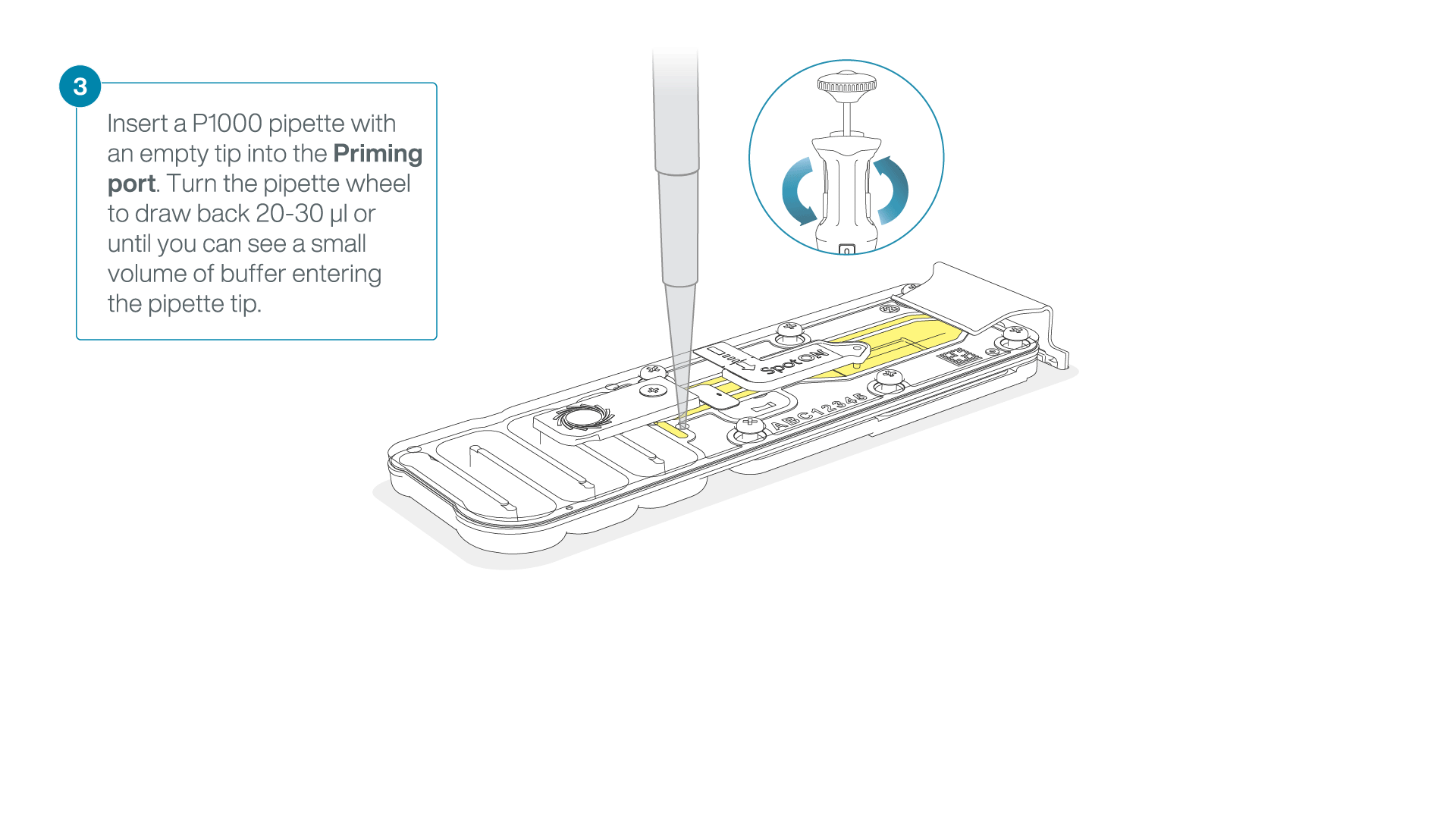
-
Load 800 µl of the priming mix into the flow cell via the priming port, avoiding the introduction of air bubbles. Wait for five minutes. During this time, prepare the library for loading by following the steps below.
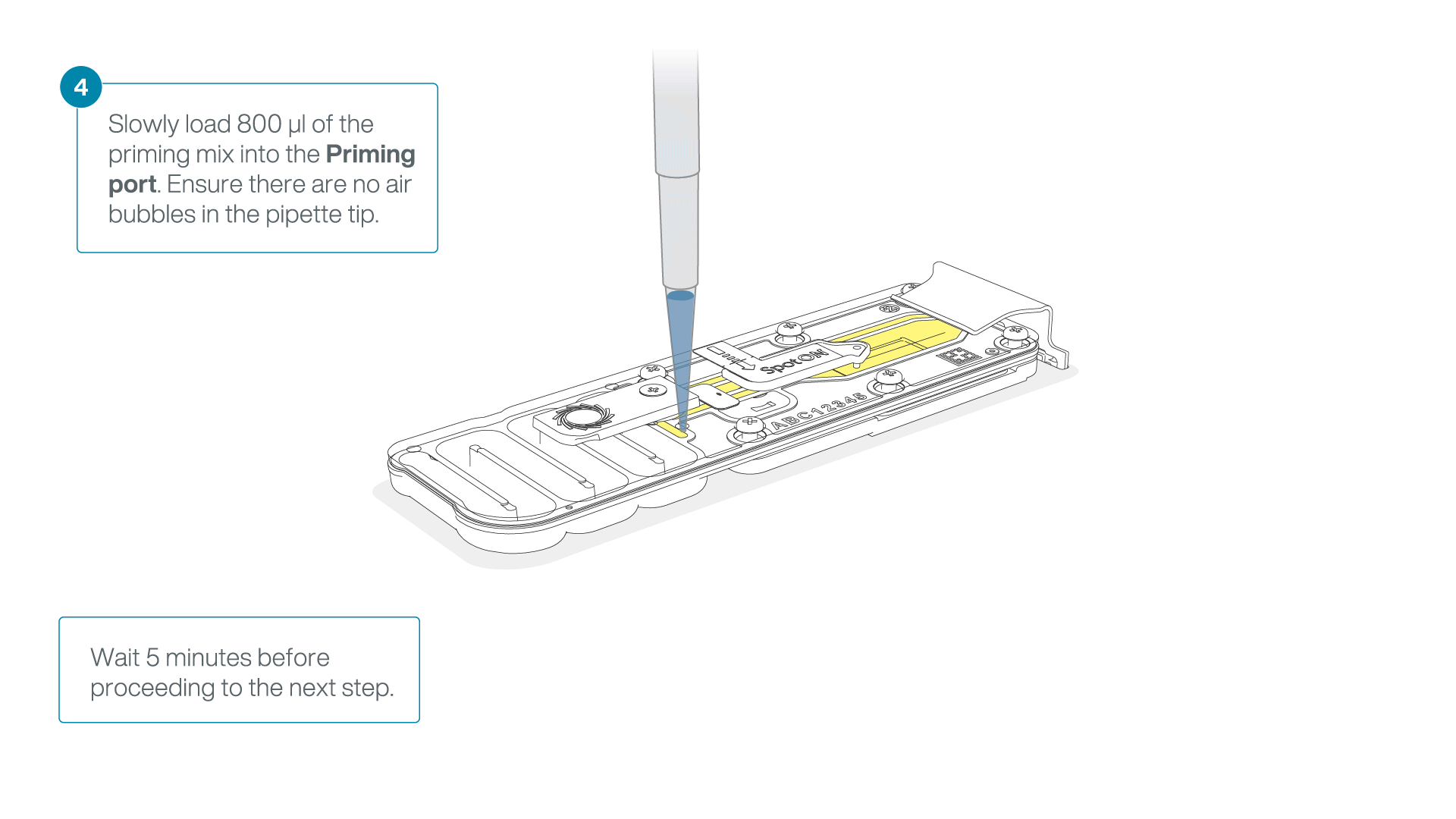
-
Thoroughly mix the contents of the Library Beads (LIB) by pipetting.
-
In a new 1.5 ml Eppendorf DNA LoBind tube, prepare the library for loading as follows:
Reagent Volume per flow cell Sequencing Buffer (SB) 37.5 µl Library Beads (LIB) mixed immediately before use, or Library Solution (LIS), if using 25.5 µl DNA library 12 µl Total 75 µl -
Complete the flow cell priming:
- Gently lift the SpotON sample port cover to make the SpotON sample port accessible.
- Load 200 µl of the priming mix into the flow cell priming port (not the SpotON sample port), avoiding the introduction of air bubbles.
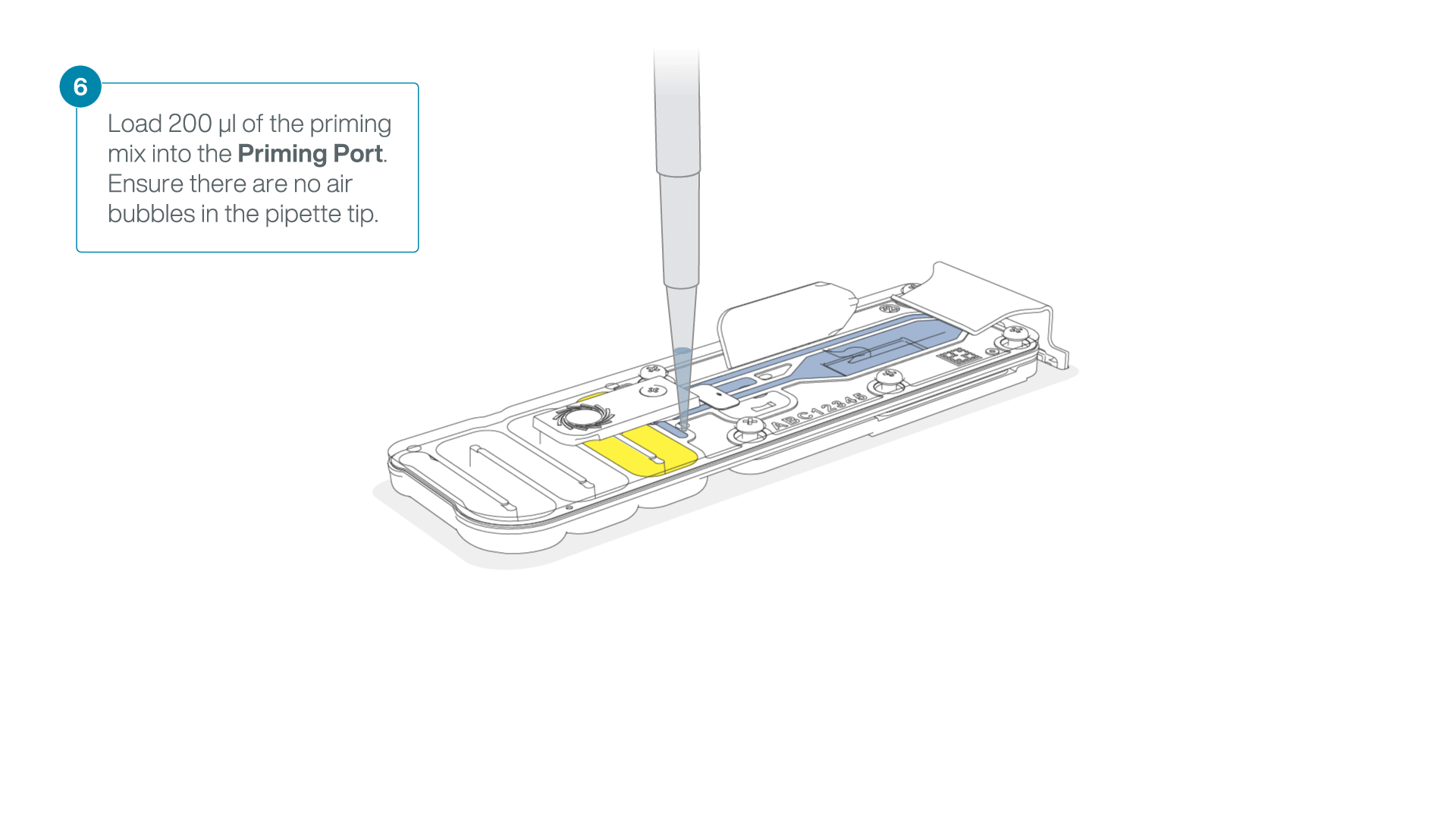
-
Mix the prepared library gently by pipetting up and down just prior to loading.
-
Add 75 μl of the prepared library to the flow cell via the SpotON sample port in a dropwise fashion. Ensure each drop flows into the port before adding the next.

-
Gently replace the SpotON sample port cover, making sure the bung enters the SpotON port and close the priming port.

-
Place the light shield onto the flow cell, as follows:
Carefully place the leading edge of the light shield against the clip.
Note: Do not force the light shield underneath the clip.Gently lower the light shield onto the flow cell. The light shield should sit around the SpotON cover, covering the entire top section of the flow cell.
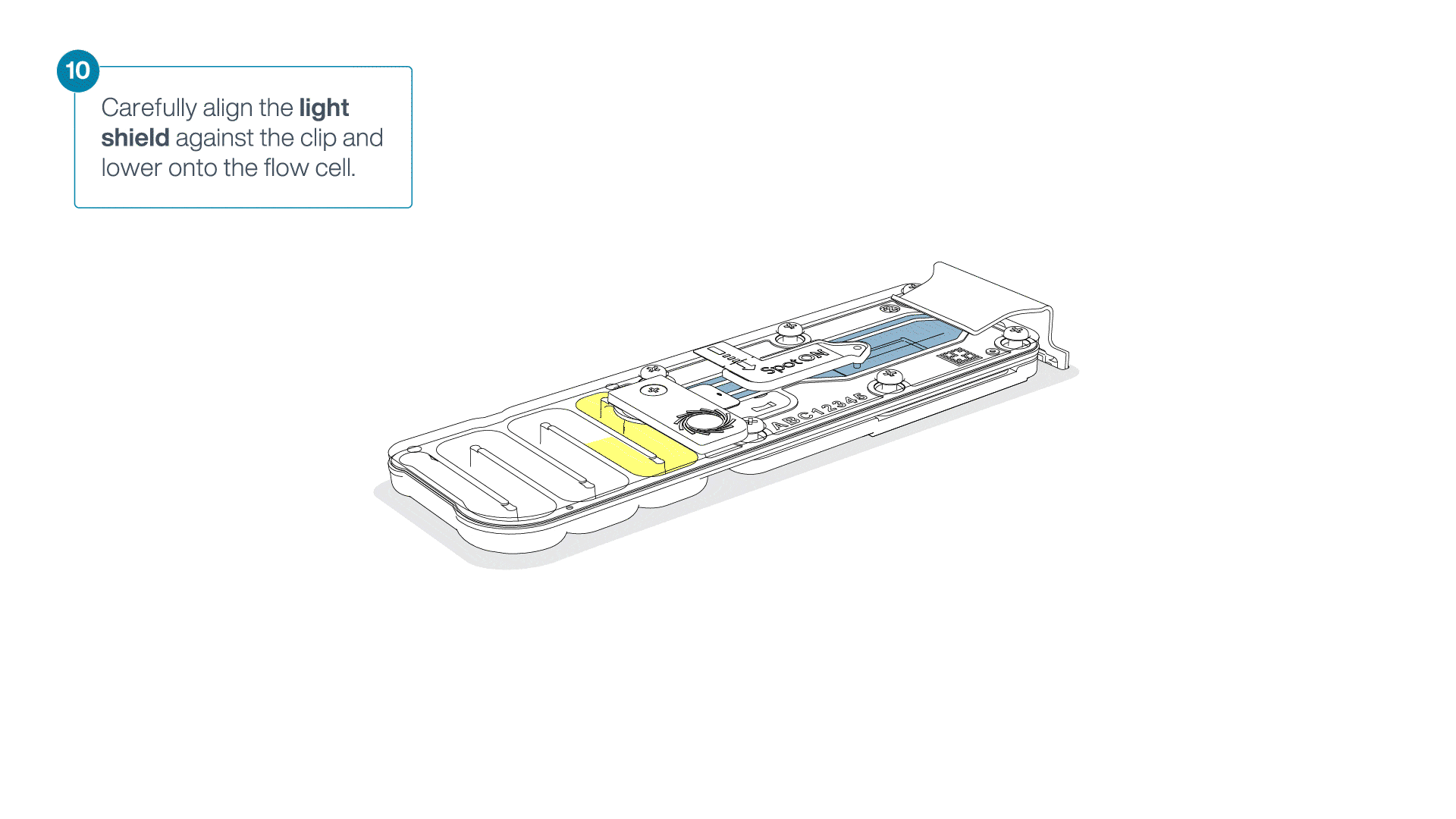
Washing and reloading a flow cell
Washing and reloading a flow cell
- Materials
-
- Flow Cell Wash Kit (EXP-WSH004)
- Sequencing Buffer (SB)
- Library Beads (LIB)
- Library Solution (LIS)
- Flow Cell Tether (FCT)
- Flow Cell Flush (FCF)
- Consumables
-
- 1.5 ml Eppendorf DNA LoBind tubes
- Equipment
-
- Vortex mixer
- Ice bucket with ice
- P1000 pipette and tips
- P200 pipette and tips
- P10 pipette and tips
-
Flow cell washing and reloading
Due to the low input material for the library preparation, low pore occupancy (<25% of active pore) can occur before enough data is generated for data analysis. Therefore, we recommend washing and reloading your flow cell with fresh library to maintain high data acquisition when approximately ~25% of active pores remain.
The Flow Cell Wash Kit removes most of the initial library as well as unblocking pores to prepare the flow cell for loading a new library for further sequencing. Pore availability can be viewed on the Pore Activity or the Pore Scan plot on MinKNOW.
-
Place the tube of Wash Mix (WMX) on ice. Do not vortex the tube.
-
Thaw one tube of Wash Diluent (DIL) at room temperature.
-
Mix the contents of Wash Diluent (DIL) thoroughly by vortexing, then spin down briefly and place on ice.
-
In a fresh 1.5 ml Eppendorf DNA LoBind tube, prepare the following Flow Cell Wash Mix:
Reagent Volume per flow cell Wash Mix (WMX) 2 μl Wash Diluent (DIL) 398 μl Total 400 μl -
Mix well by pipetting, and place on ice. Do not vortex the tube.
-
Pause the sequencing experiment in MinKNOW, and leave the flow cell in the device.
-
Remove the waste buffer, as follows:
- Close the priming port and SpotON sample port cover, as indicated in the figure below.
- Insert a P1000 pipette into waste port 1 and remove the waste buffer.
Note: As both the priming port and SpotON sample port are closed, no fluid should leave the sensor array area.
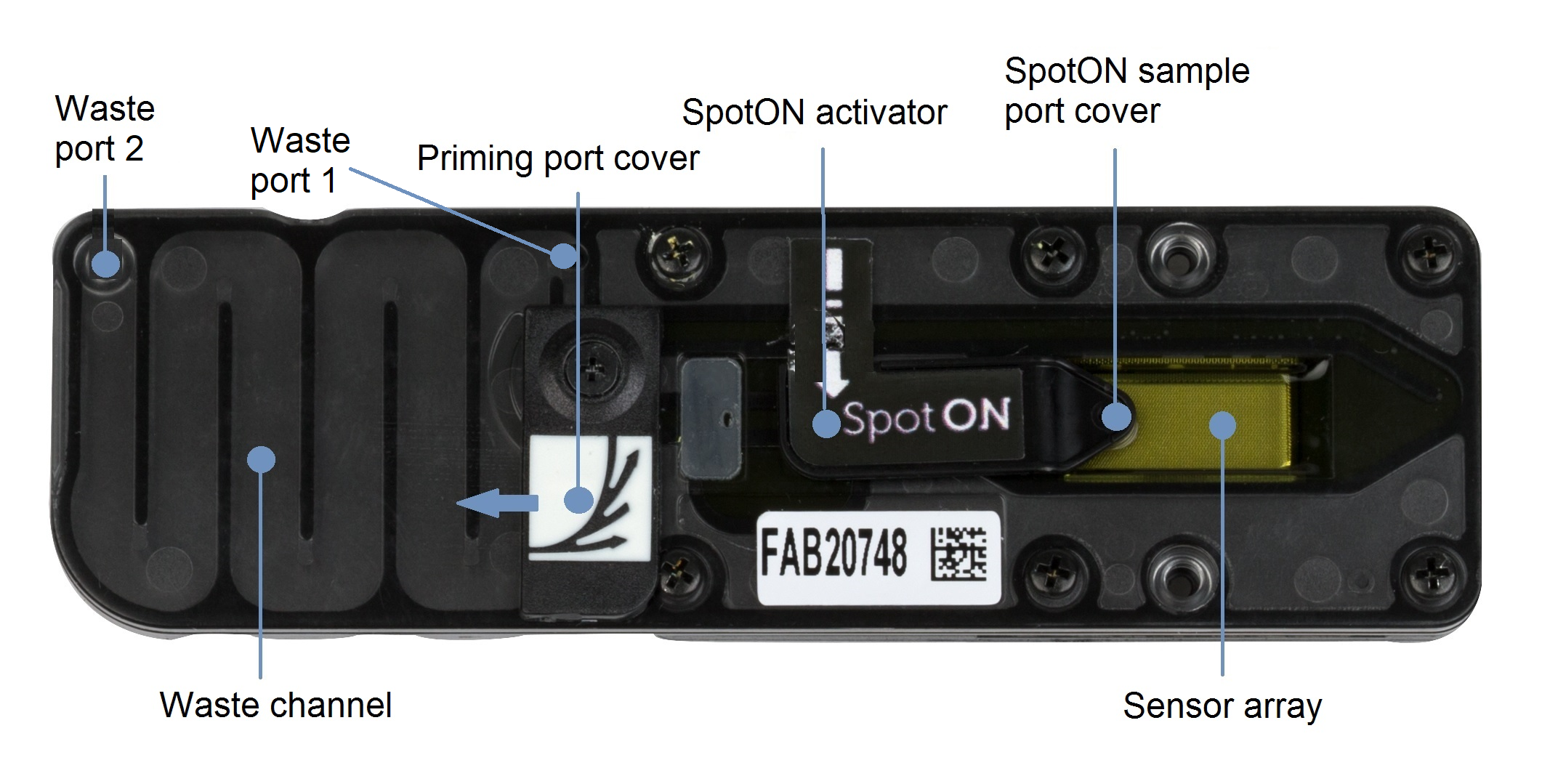
-
Slide the flow cell priming port cover clockwise to open.
-
After opening the priming port, check for a small air bubble under the cover. Draw back a small volume to remove any bubbles:
- Set a P1000 pipette to 200 µl.
- Insert the tip into the flow cell priming port.
- Turn the wheel until the dial shows 220-230 µl, or until you can see a small volume of buffer/liquid entering the pipette tip.
- Visually check that there is continuous buffer from the flow cell priming port across the sensor array.

-
Slowly load 200 µl of the prepared flow cell wash mix into the priming port, as follows:
- Using a P1000 pipette, take 200 µl of the flow cell wash mix
- Insert the pipette tip into the priming port, ensuring there are no bubbles in the tip
- Slowly twist the pipette wheel down to load the flow cell (if possible with your pipette) or push down the plunger very slowly, leaving a small volume of buffer in the pipette tip.
- Set a timer for a 5 minute incubation.
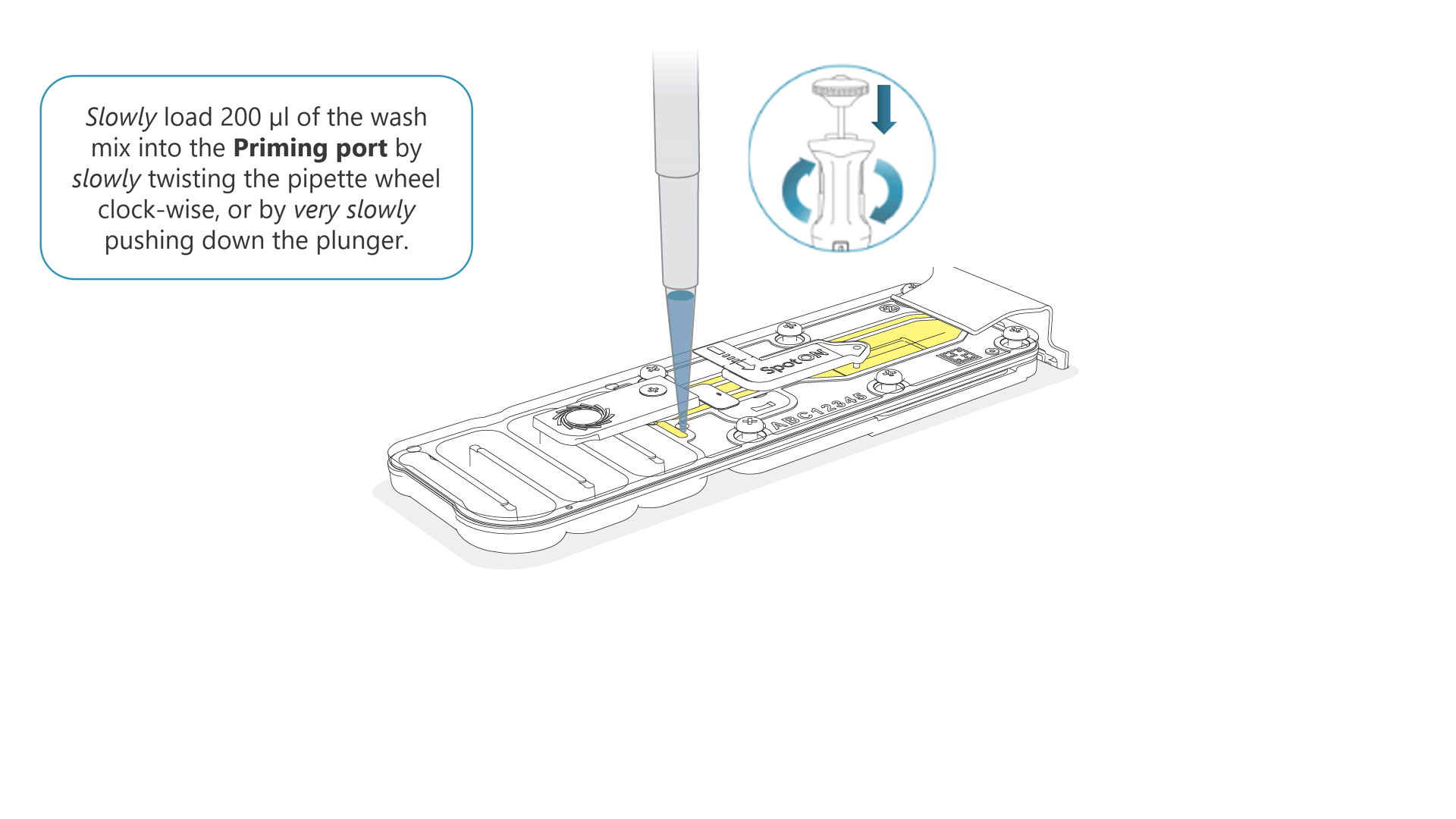
-
Once the 5 minute incubation is complete, carefully load the remaining 200 µl of the prepared flow cell wash mix into the priming port, as follows:
- Using a P1000 pipette, take the remaining 200 µl of the flow cell wash mix
- Insert the pipette tip into the priming port, ensuring there are no bubbles in the tip
- Slowly twist the pipette wheel down to load the flow cell (if possible with your pipette) or push down the plunger very slowly, leaving a small volume of buffer in the pipette tip.

-
Close the priming port and wait for 1 hour.
-
Remove the waste buffer, as follows:
- Ensure the priming port and SpotON sample port covers are closed, as indicated in the figure below.
- Insert a P1000 pipette into waste port 1 and remove the waste buffer.
Note: As both the priming port and SpotON sample port are closed, no fluid should leave the sensor array area.

-
Thaw the Sequencing Buffer (SB), Library Beads (LIB) or Library Solution (LIS, if using), Flow Cell Tether (FCT) and Flow Cell Flush (FCF) at room temperature before mixing by vortexing. Then spin down and store on ice.
-
To prepare the flow cell priming mix with BSA, combine Flow Cell Flush (FCF) and Flow Cell Tether (FCT), as directed below. Mix by pipetting at room temperature.
Note: We are in the process of reformatting our kits with single-use tubes into a bottle format. Please follow the instructions for your kit format.
Single-use tubes format:
Add 5 µl Bovine Serum Albumin (BSA) at 50 mg/ml and 30 µl Flow Cell Tether (FCT) directly to a tube of Flow Cell Flush (FCF).Bottle format:
In a suitable tube for the number of flow cells, combine the following reagents:Reagent Volume per flow cell Flow Cell Flush (FCF) 1,170 µl Bovine Serum Albumin (BSA) at 50 mg/ml 5 µl Flow Cell Tether (FCT) 30 µl Total volume 1,205 µl -
Slide the flow cell priming port cover clockwise to open the priming port.
-
After opening the priming port, check for a small air bubble under the cover. Draw back a small volume to remove any bubbles:
- Set a P1000 pipette to 200 µl.
- Insert the tip into the flow cell priming port.
- Turn the wheel until the dial shows 220-230 µl, or until you can see a small volume of buffer/liquid entering the pipette tip.
- Visually check that there is continuous buffer from the flow cell priming port across the sensor array.

-
Slowly load 800 µl of the priming mix into the priming port, as follows:
- Using a P1000 pipette, take 800 µl of the priming mix
- Insert the pipette tip into the priming port, ensuring there are no bubbles in the tip
- Slowly twist the pipette wheel down to load the flow cell (if possible with your pipette) or push down the plunger very slowly, as illustrated in the video above, leaving a small volume of buffer in the pipette tip.

-
Close the priming port and wait five minutes.
During this time, prepare the library for loading by following the steps below.
-
Thoroughly mix the contents of the Library Beads (LIB) by pipetting.
-
In a new 1.5 ml Eppendorf DNA LoBind tube, prepare the library for loading as follows:
Reagent Volume per flow cell Sequencing Buffer (SB) 37.5 µl Library Beads (LIB) mixed immediately before use, or Library Solution (LIS), if using 25.5 µl DNA library 12 µl Total 75 µl -
Remove the waste buffer, as follows:
- Ensure the priming port and SpotON sample port covers are closed, as indicated in the figure below.
- Insert a P1000 pipette into waste port 1 and remove the waste buffer.
Note: As both the priming port and SpotON sample port are closed, no fluid should leave the sensor array area.

-
Slide the flow cell priming port cover clockwise to open.
-
After opening the priming port, check for a small air bubble under the cover. Draw back a small volume to remove any bubbles:
- Set a P1000 pipette to 200 µl
- Insert the tip into the priming port
- Turn the wheel until the dial shows 220-230 µl, to draw back 20-30 µl, or until you can see a small volume of buffer entering the pipette tip
Note: Visually check that there is continuous buffer from the priming port across the sensor array.

-
Slowly load 200 µl of the priming mix into the flow cell priming port, as follows:
- Ensure the priming port is open and gently lift open the SpotON sample port.
- Using a P1000 pipette, take 200 µl of the priming mix
- Insert the pipette tip into the priming port, ensuring there are no bubbles in the tip
- Slowly twist the pipette wheel down to load the flow cell (if possible with your pipette) or push down the plunger very slowly, as illustrated in the video above, leaving a small volume of buffer in the pipette tip.
-
Remove the waste buffer, as follows:
- Close the priming port and SpotON sample port cover, as indicated in the figure below.
- Insert a P1000 pipette into waste port 1 and remove the waste buffer.
Note: As both the priming port and SpotON sample port are closed, no fluid should leave the sensor array area.

-
Slide open the priming port cover and gently lift open the SpotON sample port cover.
-
Mix the prepared library gently by pipetting up and down just prior to loading.
-
Add 75 μl of the prepared library to the flow cell via the SpotON sample port in a dropwise fashion. Ensure each drop flows into the port before adding the next.

-
Gently replace the SpotON sample port cover, making sure the bung enters the SpotON port and close the priming port.

-
Place the light shield onto the flow cell, as follows:
Carefully place the leading edge of the light shield against the clip.
Note: Do not force the light shield underneath the clip.Gently lower the light shield onto the flow cell. The light shield should sit around the SpotON cover, covering the entire top section of the flow cell.

Sequencing and data analysis
Data acquisition and basecalling
Data acquisition and basecalling
-
How to start sequencing
Once you have loaded your flow cell, the sequencing run can be started on MinKNOW, our sequencing software that controls the device, data acquisition and real-time basecalling. For more detailed information on setting up and using MinKNOW, please see the MinKNOW protocol.
MinKNOW can be used and set up to sequence in multiple ways:
- On a computer either direcly or remotely connected to a sequencing device.
- Directly on a GridION, MinION Mk1C or PromethION 24/48 sequencing device.
For more information on using MinKNOW on a sequencing device, please see the device user manuals:
- MinION Mk1B user manual
- MinION Mk1C user manual
- MinION Mk1D user manual
- GridION user manual
-
Open the MinKNOW software using the desktop shortcut and log into the MinKNOW software using your Community credentials.
-
Click on your connected device.

-
Set up a sequencing run by clicking Start sequencing.
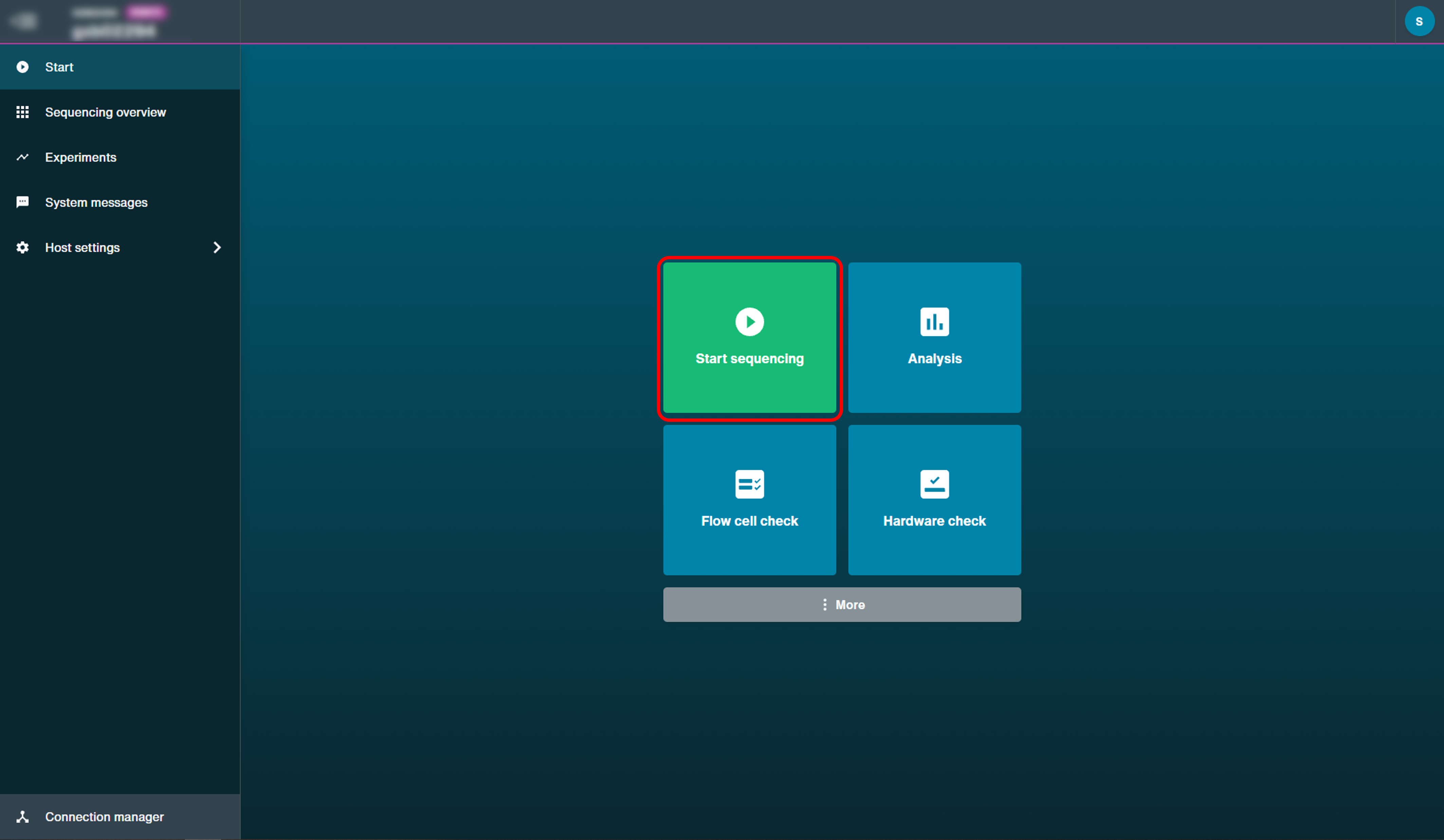
-
Click the Native Barcoding Kit 24 V14 (SQK-NBD114.24).
Click Continue to Run Options to continue.
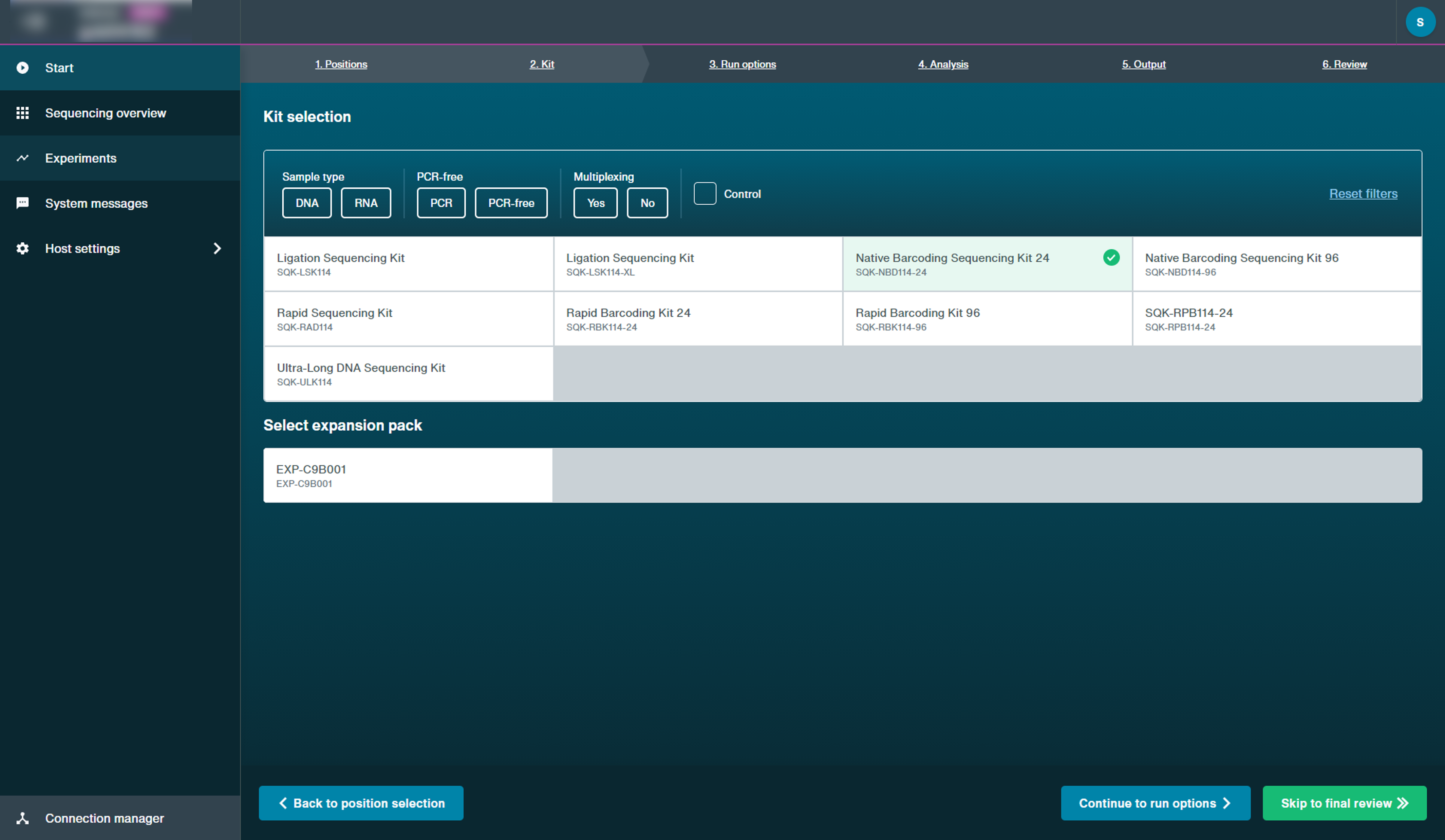
-
Keep the run options to their default settings of 72 hour run length and 200 bp minimum read length.
Minimum read length can be reduced down to 20 bp to increase output by sequencing more short reads, such as contaminanting reads including ITR tetramers. During development of this protocol, it was noted that despite the increase in short reads, a higher proportion of short reads were of lower Qscore (≤9).
Click Continue to basecalling to continue.
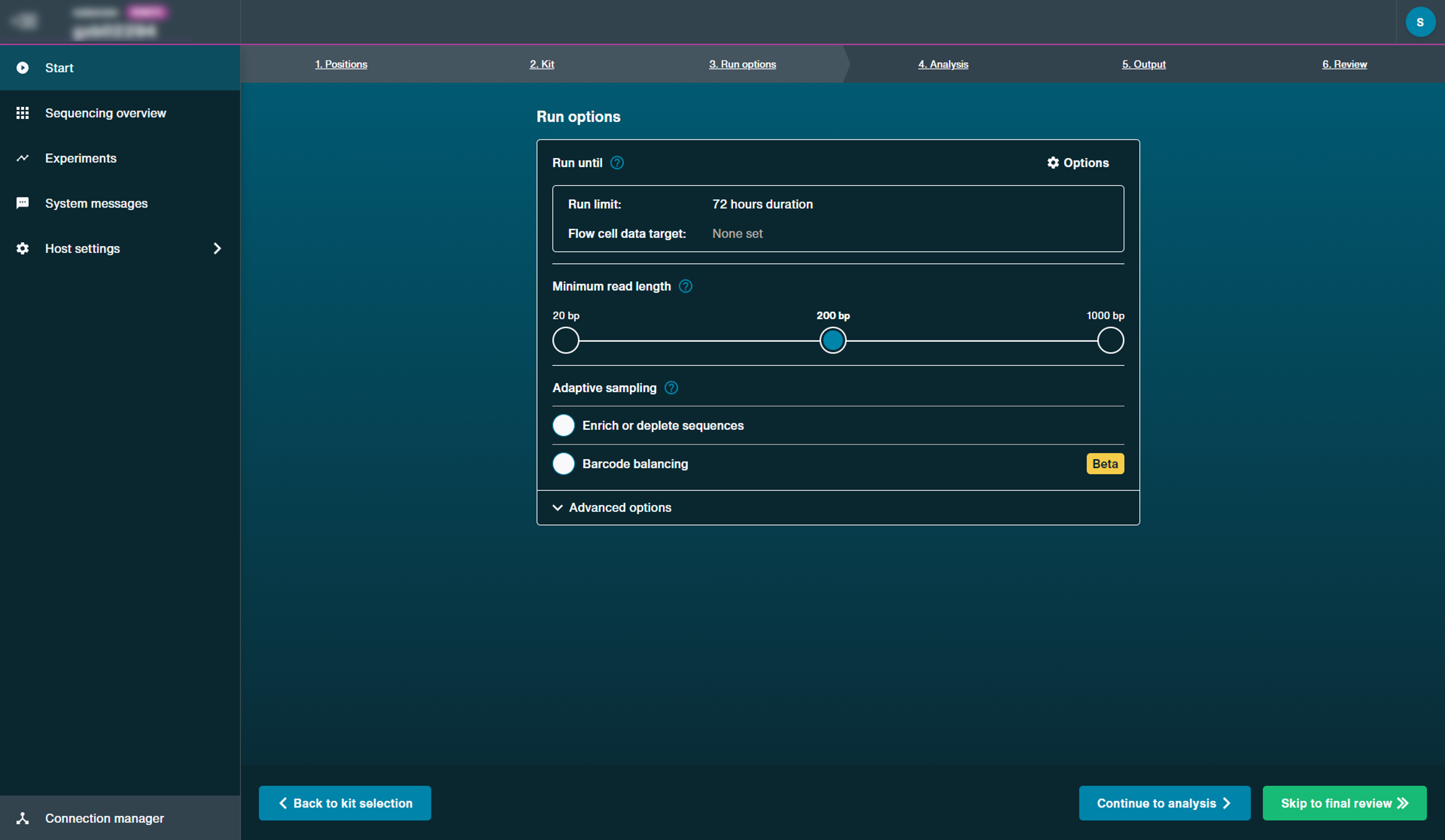
-
Set up basecalling and barcoding using the following parameters:
Ensure basecalling is ON.
Next to Models, click Edit options and choose the High accuracy basecaller (HAC) from the drop-down menu.
Ensure barcoding is ON and use the default settings.
A reference sequence may be uploaded to perform live alignment but this may slow down system processing.
Click Continue to output and continue.

-
Set up the output format and filtering as follows:
Raw reads is on and select .POD5 as the output format.
Ensure .FASTQ is selected for basecalled reads.
Filtering is on and use the default settings.
Click Continue to final review to continue.

-
Click Start to start sequencing.
You will be automatically navigated to the Sequencing Overview page to monitor the sequencing run.

-
Data analysis after sequencing
After sequencing has completed on MinKNOW, the flow cell can be reused or returned, as outlined in the Flow cell reuse and returns section.
After sequencing and basecalling, the data can be analysed, as outlined in the Downstream analysis section.
Flow cell reuse and returns
Flow cell reuse and returns
- Materials
-
- Flow Cell Wash Kit (EXP-WSH004)
-
After your sequencing experiment is complete, if you would like to reuse the flow cell, please follow the Flow Cell Wash Kit protocol and store the washed flow cell at +2°C to +8°C.
The Flow Cell Wash Kit protocol is available on the Nanopore Community.
-
Alternatively, follow the returns procedure to send the flow cell back to Oxford Nanopore.
Instructions for returning flow cells can be found here.
Downstream analysis
Downstream analysis
-
Post-basecalling analysis
We recommend performing downstream analysis using EPI2ME Labs which facilitates bioinformatic analyses by allowing users to run Nextflow workflows in a desktop application. EPI2ME Labs maintains a collection of bioinformatic workflows which are curated and actively maintained by experts in long-read sequence analysis.
Further information about the available EPI2ME Labs workflows are available here, along with the Quick Start Guide to start your first bioinformatic workflow.
For the mapping of AAV sequences for quality control and validation, we recommend using the wf-aav-qc workflow which requires Nextflow, Java, and Docker to be installed before running the workflow.
A run report will be produced and includes multiple plots to enable easy assessment of an AAV vector, including a contamination graph, truncations graph, transgene expression read coverage and genome type frequency graph.
-
Open the EPI2ME app using the desktop shortcut.
-
Click "Run this workflow" to open the launch wizard.

-
Set up your run by uploading your data files including the FASTQ input and host reference in the "Input Options". Fill in the basecaller configuration used to basecall your data and the other parameters can be kept to their default settings.
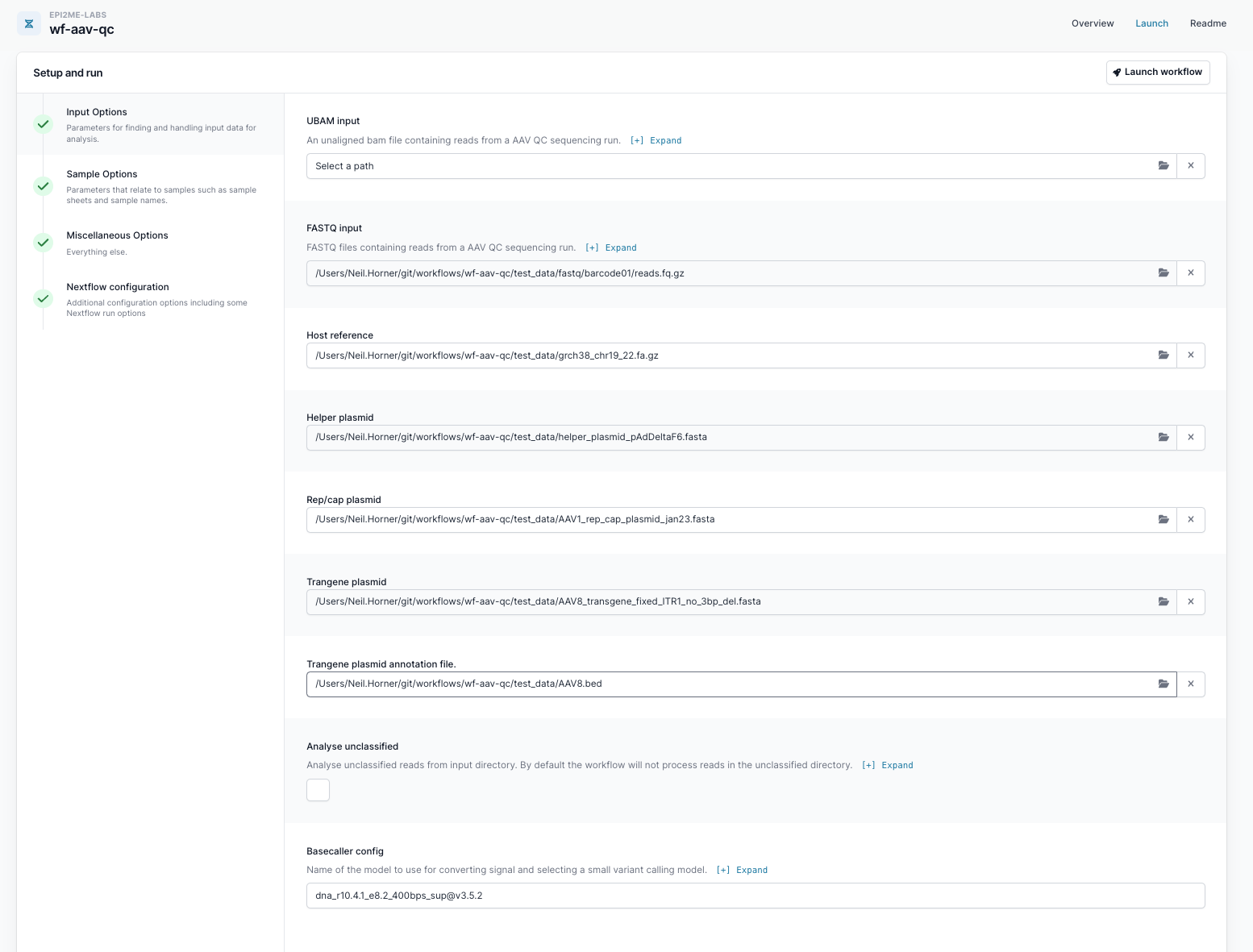
-
Click "Launch workflow" in the top right corner.
Ensure all parameters options have green ticks.

-
Once the workflow finishes, a report will be produced.
Troubleshooting
Issues during DNA/RNA extraction and library preparation for Kit 14
Issues during DNA/RNA extraction and library preparation for Kit 14
-
Below is a list of the most commonly encountered issues, with some suggested causes and solutions.
We also have an FAQ section available on the Nanopore Community Support section.
If you have tried our suggested solutions and the issue still persists, please contact Technical Support via email (support@nanoporetech.com) or via LiveChat in the Nanopore Community.
-
Low sample quality
Observation Possible cause Comments and actions Low DNA purity (Nanodrop reading for DNA OD 260/280 is <1.8 and OD 260/230 is <2.0–2.2) The DNA extraction method does not provide the required purity The effects of contaminants are shown in the Contaminants document. Please try an alternative extraction method that does not result in contaminant carryover.
Consider performing an additional SPRI clean-up step.Low RNA integrity (RNA integrity number <9.5 RIN, or the rRNA band is shown as a smear on the gel) The RNA degraded during extraction Try a different RNA extraction method. For more info on RIN, please see the RNA Integrity Number document. Further information can be found in the DNA/RNA Handling page. RNA has a shorter than expected fragment length The RNA degraded during extraction Try a different RNA extraction method. For more info on RIN, please see the RNA Integrity Number document. Further information can be found in the DNA/RNA Handling page.
We recommend working in an RNase-free environment, and to keep your lab equipment RNase-free when working with RNA. -
Low DNA recovery after AMPure bead clean-up
Observation Possible cause Comments and actions Low recovery DNA loss due to a lower than intended AMPure beads-to-sample ratio 1. AMPure beads settle quickly, so ensure they are well resuspended before adding them to the sample.
2. When the AMPure beads-to-sample ratio is lower than 0.4:1, DNA fragments of any size will be lost during the clean-up.Low recovery DNA fragments are shorter than expected The lower the AMPure beads-to-sample ratio, the more stringent the selection against short fragments. Please always determine the input DNA length on an agarose gel (or other gel electrophoresis methods) and then calculate the appropriate amount of AMPure beads to use. 
Low recovery after end-prep The wash step used ethanol <70% DNA will be eluted from the beads when using ethanol <70%. Make sure to use the correct percentage.
Issues during the sequencing run for Kit 14
Issues during the sequencing run for Kit 14
-
Below is a list of the most commonly encountered issues, with some suggested causes and solutions.
We also have an FAQ section available on the Nanopore Community Support section.
If you have tried our suggested solutions and the issue still persists, please contact Technical Support via email (support@nanoporetech.com) or via LiveChat in the Nanopore Community.
-
Fewer pores at the start of sequencing than after Flow Cell Check
Observation Possible cause Comments and actions MinKNOW reported a lower number of pores at the start of sequencing than the number reported by the Flow Cell Check An air bubble was introduced into the nanopore array After the Flow Cell Check it is essential to remove any air bubbles near the priming port before priming the flow cell. If not removed, the air bubble can travel to the nanopore array and irreversibly damage the nanopores that have been exposed to air. The best practice to prevent this from happening is demonstrated in this video. MinKNOW reported a lower number of pores at the start of sequencing than the number reported by the Flow Cell Check The flow cell is not correctly inserted into the device Stop the sequencing run, remove the flow cell from the sequencing device and insert it again, checking that the flow cell is firmly seated in the device and that it has reached the target temperature. If applicable, try a different position on the device (GridION/PromethION). MinKNOW reported a lower number of pores at the start of sequencing than the number reported by the Flow Cell Check Contaminations in the library damaged or blocked the pores The pore count during the Flow Cell Check is performed using the QC DNA molecules present in the flow cell storage buffer. At the start of sequencing, the library itself is used to estimate the number of active pores. Because of this, variability of about 10% in the number of pores is expected. A significantly lower pore count reported at the start of sequencing can be due to contaminants in the library that have damaged the membranes or blocked the pores. Alternative DNA/RNA extraction or purification methods may be needed to improve the purity of the input material. The effects of contaminants are shown in the Contaminants Know-how piece. Please try an alternative extraction method that does not result in contaminant carryover. -
MinKNOW script failed
Observation Possible cause Comments and actions MinKNOW shows "Script failed" Restart the computer and then restart MinKNOW. If the issue persists, please collect the MinKNOW log files and contact Technical Support. If you do not have another sequencing device available, we recommend storing the flow cell and the loaded library at 4°C and contact Technical Support for further storage guidance. -
Pore occupancy below 40%
Observation Possible cause Comments and actions Pore occupancy <40% Not enough library was loaded on the flow cell 10–20 fmol of good quality library can be loaded on to a MinION/GridION flow cell. Please quantify the library before loading and calculate mols using tools like the Promega Biomath Calculator, choosing "dsDNA: µg to pmol" Pore occupancy close to 0 The Native Barcoding Kit was used, and ethanol was used instead of LFB or SFB at the wash step after sequencing adapter ligation Ethanol can denature the motor protein on the sequencing adapters. Make sure the LFB or SFB buffer was used after ligation of sequencing adapters. Pore occupancy close to 0 No tether on the flow cell Tethers are adding during flow cell priming (FCT tube). Make sure FCT was added to FCF before priming. -
Shorter than expected read length
Observation Possible cause Comments and actions Shorter than expected read length Unwanted fragmentation of DNA sample Read length reflects input DNA fragment length. Input DNA can be fragmented during extraction and library prep.
1. Please review the Extraction Methods in the Nanopore Community for best practice for extraction.
2. Visualise the input DNA fragment length distribution on an agarose gel before proceeding to the library prep.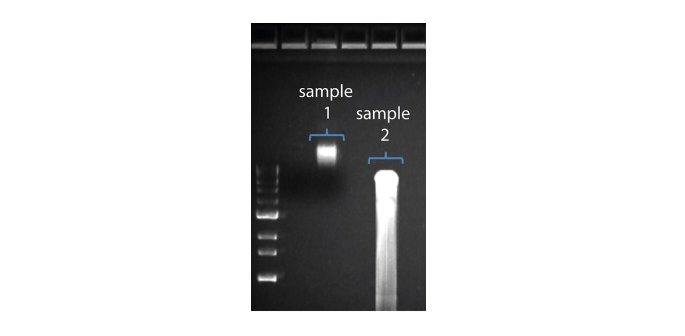 In the image above, Sample 1 is of high molecular weight, whereas Sample 2 has been fragmented.
In the image above, Sample 1 is of high molecular weight, whereas Sample 2 has been fragmented.
3. During library prep, avoid pipetting and vortexing when mixing reagents. Flicking or inverting the tube is sufficient. -
Large proportion of inactive pores
Observation Possible cause Comments and actions Large proportion of inactive/unavailable pores (shown as light blue in the channels panel and pore activity plot. Pores or membranes are irreversibly damaged) Air bubbles have been introduced into the flow cell Air bubbles introduced through flow cell priming and library loading can irreversibly damage the pores. Watch the Priming and loading your flow cell video for best practice Large proportion of inactive/unavailable pores Certain compounds co-purified with DNA Known compounds, include polysaccharides, typically associate with plant genomic DNA.
1. Please refer to the Plant leaf DNA extraction method.
2. Clean-up using the QIAGEN PowerClean Pro kit.
3. Perform a whole genome amplification with the original gDNA sample using the QIAGEN REPLI-g kit.Large proportion of inactive/unavailable pores Contaminants are present in the sample The effects of contaminants are shown in the Contaminants Know-how piece. Please try an alternative extraction method that does not result in contaminant carryover. -
Reduction in sequencing speed and q-score later into the run
Observation Possible cause Comments and actions Reduction in sequencing speed and q-score later into the run Fast fuel consumption is typically seen in Kit 9 chemistry (e.g. SQK-LSK109) when the flow cell is overloaded with library. Please see the appropriate protocol for your DNA library to find the recommendation. Add more fuel to the flow cell by following the instructions in the MinKNOW protocol. In future experiments, load lower amounts of library to the flow cell. -
Temperature fluctuation
Observation Possible cause Comments and actions Temperature fluctuation The flow cell has lost contact with the device Check that there is a heat pad covering the metal plate on the back of the flow cell. Re-insert the flow cell and press it down to make sure the connector pins are firmly in contact with the device. If the problem persists, please contact Technical Services. -
Failed to reach target temperature
Observation Possible cause Comments and actions MinKNOW shows "Failed to reach target temperature" The instrument was placed in a location that is colder than normal room temperature, or a location with poor ventilation (which leads to the flow cells overheating) MinKNOW has a default timeframe for the flow cell to reach the target temperature. Once the timeframe is exceeded, an error message will appear and the sequencing experiment will continue. However, sequencing at an incorrect temperature may lead to a decrease in throughput and lower q-scores. Please adjust the location of the sequencing device to ensure that it is placed at room temperature with good ventilation, then re-start the process in MinKNOW. Please refer to this link for more information on MinION temperature control.
Become a full member
Purchase a MinION Starter Pack from Avantor to get full community access and benefit from:
- News - hear about the latest product updates
- Posts - interact with thousands of nanopore users from around the globe
- Software - download the latest sequencing and analysis software
Already have a Nanopore Community account?
Log in hereNeed more help?
Request a call with our experts for detailed advice on implementing nanopore sequencing.
Request a callInterested in microbiology?
Visit our microbial sequencing spotlight page on vwr.com.
Microbial sequencing























 In the image above, Sample 1 is of high molecular weight, whereas Sample 2 has been fragmented.
In the image above, Sample 1 is of high molecular weight, whereas Sample 2 has been fragmented. The pore activity plot above shows an increasing proportion of "unavailable" pores over time.
The pore activity plot above shows an increasing proportion of "unavailable" pores over time.